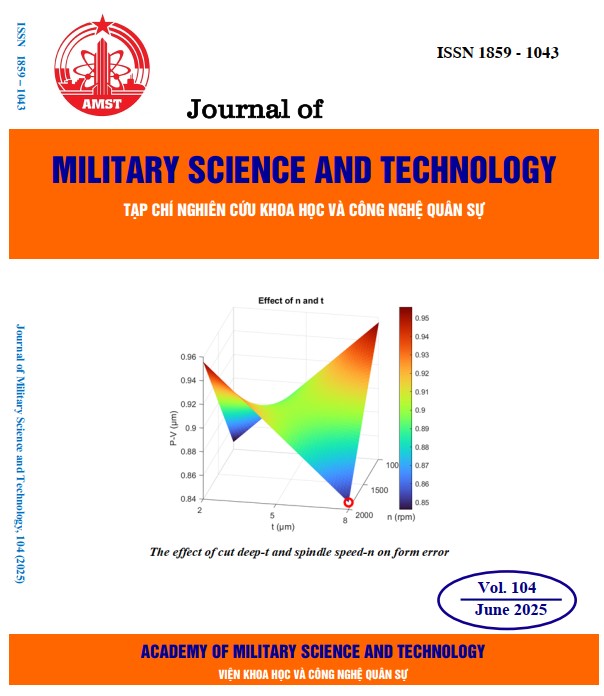The process of phase formation in the synthesis of Al2O3 - Y2O3 - SiO2 frit by sol-gel and coprecipitation method
316 viewsDOI:
https://doi.org/10.54939/1859-1043.j.mst.104.2025.94-102Keywords:
Y2O3 -Al2O3 -SiO2; Frit; Ceramics; SiAlON.Abstract
Frits are utilized in various high-temperature and structural applications due to their exceptional properties. However, most frits are fabricated via solid-state reactions, which require high sintering temperatures and extended time to achieve homogeneity. Therefore, this study investigates the phase transition in the Al2O3 -Y2O3 -SiO2 frit using sol-gel method, which enables lower synthesis temperature and achieves higher purity. The energy dispersive X-ray spectroscopy (EDX) results confirm the successful fabrication of Al2O3 -Y2O3 -SiO2 frits. The effect of the sintering conditions on the phase transition was studied. The X-ray diffraction patterns revealed that the frit remained completely amorphous up to 1000 °C. Although the crystalline phases Y2O3·2SiO2, Y2O3·SiO2, and α-Al2O3 begin to appear around 1100 °C, the overall degree of crystallinity increases with temperature, indicating a gradual transformation from an amorphous to a more crystalline structure. A fully crystallized structure of the Al2O3 -Y2O3 -SiO2 frit is observed at 1400 oC. The differential thermal analysis (TGA) results confirm the glass transition, crystallization and eutectic temperature of the Al2O3 -Y2O3 -SiO2 frit. The optimized sintering condition was determined to be 1400 oC for 5 hours.
References
[1]. TCVN 6530-3:2016: Vật liệu chịu lửa - Phần 3. Xác định khối lượng thể tích, độ hút nước.
[2]. Malinverni, C., et al., "A yttrium aluminosilicate glass-ceramic to join SiC/SiC composites". Journal of the European Ceramic Society. 44(6): p. 3579-3587, (2024). DOI: https://doi.org/10.1016/j.jeurceramsoc.2023.12.095
[3]. L. Sun, S. Wang, C. Hou, D. Wang, "Microstructure, mechanical property and bonding mechanism of SiC ceramic joint using a novel Y2Si2O7/Mullite glass-ceramic interlayer". Ceram. Int. 49: p. 17885-17893, (2023). DOI: https://doi.org/10.1016/j.ceramint.2023.02.155
[4]. Yang, S., et al., "Effect of CaO doping on the properties and crystallization behavior of Y2O3–Al2O3–SiO2 glass". Ceramics International. 49(20): p. 33188-33196, (2023). DOI: https://doi.org/10.1016/j.ceramint.2023.08.022
[5]. J. Denga, B. Lu, K. Hu, J. Wang, "Interaction between Y-Al-Si-O glass-ceramics for environmental barrier coating materials and Ca-Mg-Al-Si-O melts". Ceram. Int. 46: p. 18262-18273, (2022). DOI: https://doi.org/10.1016/j.ceramint.2020.05.037
[6]. L. Sun, X. Shi, X. Liu, J. Fang, C. Liu, "Joining of Cf/SiC composites and Si3N4 ceramic with Y2O3-Al2O3-SiO2 glass filler for high-temperature applications". Ceram. Int. 47: p. 15622-15630, (2021). DOI: https://doi.org/10.1016/j.ceramint.2021.02.132
[7]. Zheng, Q., et al., "Crystallization behavior and IR structure of yttrium aluminosilicate glasses". Journal of the European Ceramic Society. 40(2): p. 463-471, (2020). DOI: https://doi.org/10.1016/j.jeurceramsoc.2019.09.044
[8]. Ahmad, S., "Rare-earth Aluminosilicate (RE2O3-Al2O3-SiO2) Glasses and Their Application as Solders for Joining of Silicon Carbide Components", KIT-Bibliothek, (2018).
[9]. S. Ahmad et al., "Application of Nd2O3-Al2O3-SiO2 glass solder for joining of silicon carbide components". J. Eur. Ceram. Soc. (2016). DOI: https://doi.org/10.1016/j.jeurceramsoc.2016.01.020
[10]. L. Gozzelino, V. Casalegno, G. Ghigo, T. Moskalewicz, "He-irradiation effects on glass-ceramics for joining of SiC-based materials". J. Nucl. Mater. 472: p. 28-34, (2016). DOI: https://doi.org/10.1016/j.jnucmat.2016.01.024
[11]. Yong Li, B. You, W. Zhao, W. Zhang, "Synthesis and Luminescent Properties of Nano-scale Y2Si2O7 :Re3+ (Re=Eu, Tb) Phosphors via Sol-Gel Method". Chinese Journal of Chemical Physics. 21(4):376-380, (2008). DOI:10.1088/1674-0068/21/04/376-380. DOI: https://doi.org/10.1088/1674-0068/21/04/376-380
[12]. H. Cinkaya, G. Eryurek, B. D. Bartolo, "White light emission based on both upconversion and thermal processes from Nd3+ doped yttrium silicate". Ceramics International. 44(4): p. 3541-3547, (2018). https://doi.org/10.1016/j.ceramint.2017.11.042. DOI: https://doi.org/10.1016/j.ceramint.2017.11.042
[13]. E. Ringdalen, M. Tangstad, "Softening and Melting of SiO2, an Important Parameter for Reactions with Quartz in Si Production". Advances in Molten Slags, Fluxes, and Salts: Proceedings of the 10th International Conference on Molten Slags, Fluxes and Salts. p.43-51, (2016). DOI:10.1007/978-3-319-48769-4_4. DOI: https://doi.org/10.1007/978-3-319-48769-4_4
[14]. C. E. Curtis, "Properties of Yttrium Oxide Ceramics". Journal of the American Ceramic Society. 40(8): p.274 - 278, (2006). DOI:10.1111/j.1151-2916.1957.tb12619.x. DOI: https://doi.org/10.1111/j.1151-2916.1957.tb12619.x







